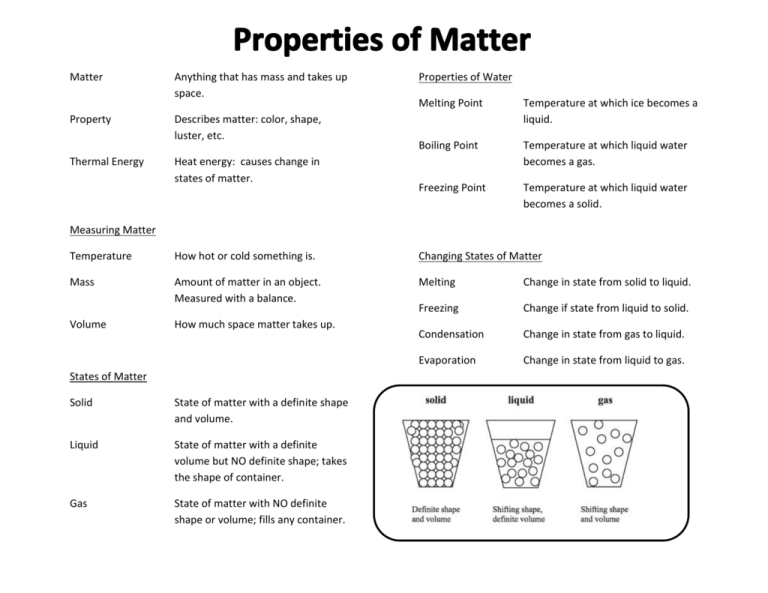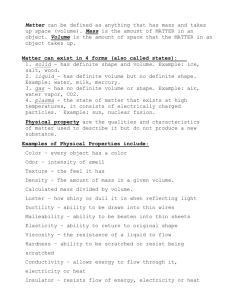Matter Anything that has mass and takes up space. Property
advertisement

Matter Property Thermal Energy Anything that has mass and takes up space. Describes matter: color, shape, luster, etc. Heat energy: causes change in states of matter. Properties of Water Melting Point Temperature at which ice becomes a liquid. Boiling Point Temperature at which liquid water becomes a gas. Freezing Point Temperature at which liquid water becomes a solid. Measuring Matter Temperature How hot or cold something is. Changing States of Matter Mass Amount of matter in an object. Measured with a balance. Melting Change in state from solid to liquid. Freezing Change if state from liquid to solid. Condensation Change in state from gas to liquid. Evaporation Change in state from liquid to gas. Volume How much space matter takes up. States of Matter Solid State of matter with a definite shape and volume. Liquid State of matter with a definite volume but NO definite shape; takes the shape of container. Gas State of matter with NO definite shape or volume; fills any container. Texture The way something feels. Cotton feels soft and sandpaper feels rough. Flexible The ability to bend back and forth without breaking. Wires are flexible. Luster How shiny things are. Things with high luster reflect light. Things that have low luster are dull. Flammable Ability to burn. Elastic The ability to stretch. Rubber bands are very elastic. Weight A measure of the pull of gravity. Spring scales are used to measure weight. Vibration Conductors & Insulators Conductor Allows energy to go through it. Copper wires allow electricity to pass through them. Pots for cooking allow heat energy to pass through them so you can heat up food. Insulator Does NOT allow energy to pass through it. Rubber gloves do not let electricity to pass through. Pot holders and insulated gloves don’t let the heat from a hot dish go through them. Mixtures & Solutions Mixture Combination of two or more things that keep their own properties. They can be separated easily. Solution A special mixture created when two substances mix together evenly and share properties. Dissolve A process. When a solid mixes evenly with a liquid. Soluble Ability of a substance to dissolve in water. They are used to create solutions. Back and forth movement that causes heat and sound. Magnetism Ability to attract iron, nickel, and cobalt Buoyancy The ability to float. Density How much matter there is in a given volume. It determines buoyancy. Gases have less density than the other states of matter.











